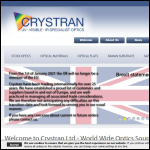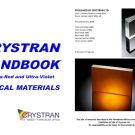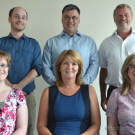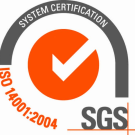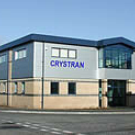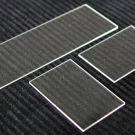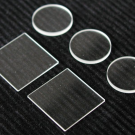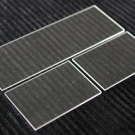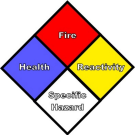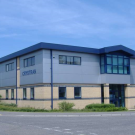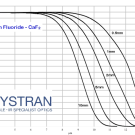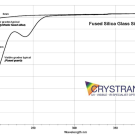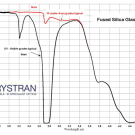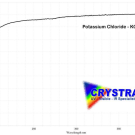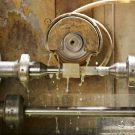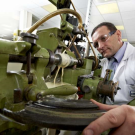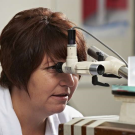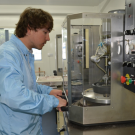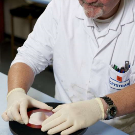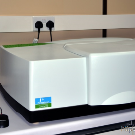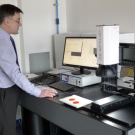- 60,000 contract/tender opportunities per year
- 4 Million UK Companies listed
- 12 million Director Names
- 100 million web pages indexed
Crystran Ltd
Overview
Products
Crystran Ltd specialises in the manufacture and supply of optical components. We manufacture high quality windows, lenses, prisms and specialist optics using a wide range materials, including calcium fluoride, barium fluoride, magnesium fluoride, zinc sulphide, zinc selenide, geranium, and many other exotic materials. Our products are used in ultraviolet, visible and infrared optical systems all over the world. A wide variety of windows, lenses, prisms and ATRs are available as standard products, but we also manufacture bespoke optical components for specialist applications. In fact, the very nature of the IR, UV and visible optics industry means that custom components form the bulk of our operations. Crystran draws upon the experience of its optical experts and utilises state-of-the-art technologies to deliver first class solutions in line with our customers' design requirements. Customised optics can be manufactured as prototypes and in larger quantities. Our reputation as a leading manufacturer of windows, lenses, and prisms extends to the four corners of the globe. The quality of our products has been the cornerstone of our success for many years, and we remain fully committed to the ongoing improvement in product and service standards. Our operations are constantly monitored to ISO 9001 standards to ensure quality is maintained. Crystran is also now accredited to the Environmental Standard ISO 14001:2004. We employ an expert team of sales staff that possess in-depth knowledge not only of the optical components themselves, but also of the chemistry and physics of materials and crystal growth. They can provide all the advice and guidance you need to indentify the right product for your application. Give them a call or send a fax or email, and they’ll get back to you immediately with a response to your query. One of the many reasons why customers keep coming back to Crystran is our flexible approach to manufacturing. Whether you need a single optic or a high volume manufacturing run, we’re always ready to accommodate your needs. Crystran works with a wide range of crystals and innovative glasses that are valued for their transmission properties. You can find out more about these in the short summaries below. More information can be found by visiting the Crystran website, where Pdf downloads are available detailing each and every material that we use. If you would like any further advice or guidance regarding Crystran and the products we offer, please do not hesitate to get in touch with our experts.
Calcium Fluoride (CaF2)
Calcium Fluoride is commonly used to produce windows, prisms and lenses used in IR applications. The purest grades of Calcium Fluoride are often used in UV applications such as UV Excimer Laser Windows. It is available doped with Europium as a beta and low energy gamma-ray scintillator.To find out more, simply follow the link.

Barium Fluoride (BaF2)
Barium Fluoride is commonly used in spectroscopic components and is suitable for applications in the passive IR band (8 to 14µm). It can also be used as view-port window for thermography. The highest quality Barium Fluoride is the fastest known scintillator material and may be employed in High Energy Physics Experiments. BaF2
Geranium (Ge)
This is a high index material that is used to manufacture Attenuated Total Reflection (ATR) prisms typically employed for spectroscopy. With a refractive index of 4.0026 at 11µm, Geranium makes an effective natural 50% beamsplitter without the need for coatings. It is also extensively used as substrate for production of optical filters. AR Coatings can be applied to produce an extremely tough front optic. For information on transmission range, reflection loss, absorption coefficient, density, melting point, conductivity and hardness, head directly to the Crystran website.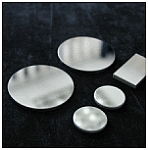
Lithium Fluoride (LiF)
Lithium Fluoride is the material with the most extreme UVV transmission of all, and as such is used for specialised UV optics. It transmits very well into the VUV region.

Magnesium Fluoride (MgF2)
Magnesium Fluoride transmits well into the VUV region to the hydrogen Lyman-alpha line (121nm) and beyond. It is most commonly used for UV optics and is excellent for Excimer laser applications. Magnesium Fluoride is a tough material that polishes very well. It can be worked to the very highest standards, and is usually supplied with the optic axis cut perpendicular to the window faces. For more information and specifications, just follow the link.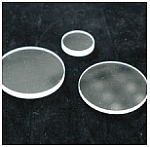
Quartz Crystal (SiO2)
Quartz crystal is a synthetically produced material that is widely used as a wave retardation medium.The birefringent properties of Quartz are of use in quarter-wave plates and in polarisers. It is also often used for electronic filters and resonators. Crystalline quartz should not be processed or used a temperature greater than 490°C – this is because it will start to revert to a glassy state where annealing is unlikely, and component fracture is very probable.
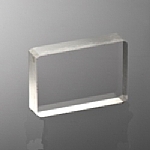
Sapphire (Al2O3)
Sapphire is highly valued for its extreme toughness and strength. It is a very useful optical window material that can be used in UV, visible and near infrared applications.
Diamond - Cubic Carbon (C)
Diamond is widely used for transmission windows and domes. It is available either as single crystal (Type IIa), natural, synthetic or as polycrystalline CVD film.
Single crystal diamond is selected into four forms:
Ia ~98% of natural yield (>100ppm Nitrogen - yellow)
Ib ~0.1% of natural yield (~100ppm Nitrogen)
IIa ~2% of natural yield (1ppm Nitrogen)
IIb - Synthetic only (100ppm boron for electronic applications)
Type IIa is the only type used for optical applications. Diamond
features IR transmission with a range of absorptions in the mid-IR between 2.5
and 7 microns due to lattice resonances.

Silicon (Si)
This material is mostly used as an optical window - primarily in the 3 to 5 micron band - and also as a substrate for the production of optical filters. Large blocks of silicon with polished faces are used as neutron targets in physics experiments. It has a transmission range of 1.2 to 15µm, a refractive index of 3.4223 at 5µm, and reflection loss of 46.2% at 5µm. If you would like to find out more about the properties and uses of silicone in optics, head to the Crystran website, where you will also find Pdf technical data sheets on all of the materials we use to make glasses, lenses and prisms.Zinc Selenide (ZnSe)
Zinc Selenide is widely used for IR components, windows, lenses and for spectroscopic ATR prisms. It is microcrystalline in structure and is produced by synthesis from zinc vapour and H2Se gas which forms as sheets on graphite susceptors. Zinc Selenide oxidises significantly at 300 degress C, exhibits plastic deformation at approximately 500 degrees C and dissociates at about 700 degrees C. Please follow the link to our website to view our Zinc Selenide datasheets and product notes.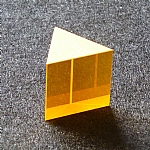
Zinc Sulphide Multispectral (Zinc Sulfide) (ZnS)
Zinc Sulphide Multispectral is used for IR windows and lenses in the thermal band (8 to 14µm) where maximum transmission and lowest absorption is required. Zinc Sulphide is microcrystalline in structure and is produced from zinc vapour and H2S gas forming as sheets on graphite susceptors. Zinc sulphide oxidises significantly at 300 degress C, exhibits plastic deformation at approximately 500 degrees C and dissociates at about 700 degrees C. Please follow the link to our website to view our Zinc Sulphide Multispectral datasheets and product notes.
Silver Chloride (AgCl)
Silver Chloride is widely used for deep IR applications where sensitivity to moisture is problematic.After using heat and pressure to deform the soft crystal, it can be formed in polished dies to create IR windows and lenses. Silver Chloride is widely used in the manufacture of small, disposable cell windows for spectroscopy, known as mini-cells. Please follow the link to our website to view our Silver Chloride datasheets and product notes.

Silver Bromide (AgBr)
For very deep IR applications where moisture sensitivity may be a problem, Silver Bromide is a useful solution. Relative to many other IR materials, Silver Bromide crystal growth was only developed recently, meaning that its parameters have not been researched quite as thoroughly as Silver Chloride's parameters.Soft Silver Bromide crystals deform under heat and pressure, so they can be forged in polished dies to make IR windows and lenses.

Caesium Iodide (CsI)
The material with the deepest known IR transmission is Caesium Iodide, which can be used for components in spectrophotometers with the widest range. It is incredibly difficult to polish, due to being a very soft material, which means that performance has to be compromised for range. Caesium Iodide can be a useful scintillator when doped with Thallium, as it emits at a wavelength that matches Silicon photodiodes well. Security imaging systems often make use of arrays of Caesium Iodide.
Windows
We can provide optical windows made from an extensive range of materials, including barium fluoride, calcium fluoride, caesium iodide, germanium, KRS5, magnesium fluoride, quartz crystal, silica glass, zinc selenide, silicon, sapphire, gallium arsenide, potassium bromide and more. These windows come in circular, rectangular and large formats, and include a range of properties, such as UV, VUV, anti-reflection, IR grade and Czochralski grade.For a full list of these products, please visit our website.
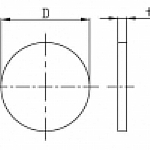
Lenses
We can also provide lenses made from calcium fluoride, silica glass, barium fluoride, zinc sulphide, magnesium fluoride and zinc selenide. These lenses include positive and negative shapes, with piano, meniscus and bi options.For a more in depth look at our lenses, including specifications, please visit our website.
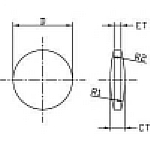
Prisms and ATR
We can provide a range of dispersing prisms and ATR (attenuated total reflection) spectroscopy prisms, made from barium fluoride, germanium, calcium fluoride, KRS5, sapphire, silica glass, optical glass, silicon or zinc selenide. These come in a variety of angles, including 30° reflecting, 45° right angle reflective, 60° equilateral dispersing and 67° and 74° brewster.For specific details on our prism products, including dimensions and angles, please visit our website.
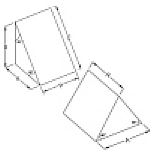
Beamsplitters
We can also provide beamsplitters, in calcium fluoride or zinc selenide. For details on dimensions and angles, please visit our website.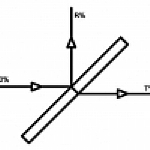
Manuals & Brochures
Details
Info
| Registration Number: | 02863378 |
| VAT Number: | GB619 6814 12 |
| Registered at Companies House: | 19 October, 1993 (30 years and 6 months ago) |
| No of Employees: | 21-50 |
| Annual Turnover: | n/a |
| Importers: | |
| Exporters: | |
| Company Type: |
|
Opening Times
| Monday | 09:00 AM - 05:30 PM |
| Tuesday | 09:00 AM - 05:30 PM |
| Wednesday | 09:00 AM - 05:30 PM |
| Thursday | 09:00 AM - 05:30 PM |
| Friday | 09:00 AM - 05:30 PM |
| Saturday | Closed |
| Sunday | Closed |
Questions
Additional Information
Company Certifications
| ISO 9001:2015 - Quality management systems – Requirements |
| ISO 14001:2015 - Environmental management systems – Requirements with guidance for use |
Gallery
Financial Information
To view more detailed financial information for this company click here.
- Park Coner Pvt Ltd
- Kitchen Theory Ltd
- Universal Remote Control
- Uplifting Home Care Ltd
- Juniper Cakery Ltd
- Pipe, Pipework Repair Products
- CARDIFF
- Clever Adviser Technology Ltd
- Concab Electrical Ltd
- Paradigm Global Services (UK) Ltd
- Cousins Engineering
- Jtd Entertainment Ltd
- High Power Diode Lasers
- Cotton Bags
- Turner & Price Ltd
- KELLY MORRIS IT Ltd
- Global Charters Ltd
- Axial Seals
- PVC Fabricators (Polyvinyl Chloride)



